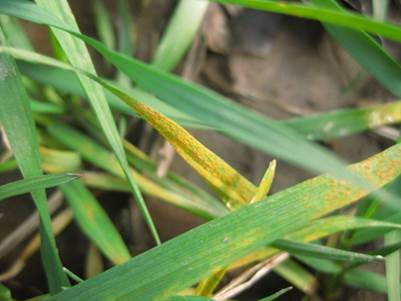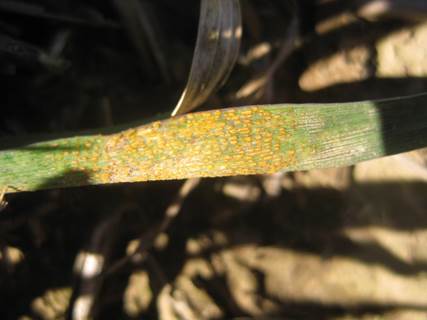Xianming Chen
Severe stripe rust forecasted for the eastern Pacific Northwest
Based on our forecast models using the weather conditions from November 2015 to February 2016, stripe rust will potentially cause yield loss of 53% on highly susceptible varieties, indicating an epidemic in the severe (40-60% yield loss on susceptible varieties) range. This prediction is much higher than the 35% forecasted in January based only on the November-December weather conditions. If highly susceptible varieties have 53% yield losses, the currently grown winter wheat cultivars will have yield losses from 0 to 26%.
Stripe rust found in Garfield, Walla Walla, Benton, Grant, and Adams counties, WA
On Mar 3, we were checking wheat fields in Whitman, Walla Walla, Benton, Franklin, and Adams counties in Washington, winter wheat plants ranged from tillering (Feekes 2) to early jointing (Feekes 5). Big differences were observed in crop uniformity resulted from the soil moisture conditions in the last fall. We found stripe rust on susceptible varieties in winter wheat breeding nurseries in Central Ferry (Garfield Co.), our stripe rust experimental field in Walla Walla (Fig. 1), and commercial fields in Horse Heaven Hills (Benton) (Fig. 2), east of Moses Lake (Grant Co.), and southeast of Odessa (Adams Co.). Stripe rust was very easy to find in the breeding and rust nurseries with incidence (number of plants with rust) between 1 and 3%. Some plants with several leaves including top leaves infected, and in some spots, two or more plants had rust. In commercial fields, finding stripe rust was easier in fields of the Horse Heavy Hills region than in fields between Moses Lake and Odessa. Rust incidence was less than 1% in commercial fields if rust was found. On February 29, Pete Martin also found stripe rust in a field between Moses Lake and Odessa. Compared to the last year, the appearance of stripe rust is similar in Walla Walla, but this year, we found stripe rust in more locations. The development of stripe rust is much earlier than normal.
Fig. 1. Stripe rust on wheat plants found on susceptible varieties in an experimental field near Walla Walla on March 3, 2016.
Fig. 2. Stripe rust on a wheat leaf found in a commercial field in Horse Heaven Hills on March 3, 2016. In the fields, many plants were found with rust.
Recommendations for the Pacific Northwest
As stripe rust has been found in Oregon and Washington and is predicted to be severe, control of stripe rust is necessary this year. Some general recommendations for the eastern Pacific Northwest are the following:
- For winter wheat, check your field just before herbicide application. If a susceptible or moderately susceptible winter wheat variety (ratings 5 to 9 on the Buyers’ Guide) is planted, or you can found stripe rust in the field, consider using fungicide at the time of herbicide application.
- For spring wheat, consider planting resistant varieties and avoid susceptible ones. Use the Seed Buyers Guide to choose varieties rated 1 to 4 for stripe rust and avoid those rated 5-9 if possible.
- Based on some of the weather forecasts for the Pacific Northwest, we may have good moistures through May. This is good for high yield potential, but also good for stripe rust development. As this rust season has already started and is likely a much longer one than normal, second application may be needed around the flag leaf stage, depending upon the first time of fungicide application, rust re-development in the field, variety with high-level of high-temperature adult-plant resistance or not, and weather conditions. General recommendation for using second application or not will be made late as the season and rust progress.
Stripe rust in other states
So far, stripe rust has been reported in Texas, Oregon, Louisiana, Arkansas, Oklahoma, and Washington. Stripe rust was first found in Texas in January and developed quickly in the recent weeks. In the first week of February, stripe rust was reported in Willamette Valley in western Oregon, and near Hermiston in northeastern Oregon in the second week of February. In this week, stripe rust was reported in Louisiana, Arkansas, and Oklahoma, as well as Washington. Such early development and spreading of stripe rust in the southern Great Plains is earlier than normal and similar to the last year, indicating another severe stripe rust epidemic throughout the Great Plains and further into the east regions. Application of fungicides is recommended for fields grown with susceptible varieties. Fungicide timing needs to be based on local recommendations.

